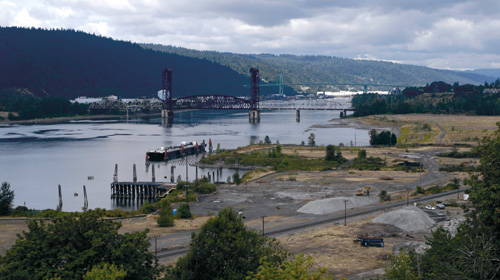 Environmental officials are quick to assert that Oregon’s most expensive publicly funded cleanup is not failing from an environmental perspective. But from a real estate perspective, the $55 million cleanup of the former McCormick & Baxter creosote factory in North Portland has created complications.
Environmental officials are quick to assert that Oregon’s most expensive publicly funded cleanup is not failing from an environmental perspective. But from a real estate perspective, the $55 million cleanup of the former McCormick & Baxter creosote factory in North Portland has created complications.
 |
The former McCormick & Baxter creosote factory in North Portland.// Photo by Michael G. Halle |
Environmental officials are quick to assert that Oregon’s most expensive publicly funded cleanup is not failing from an environmental perspective. But from a real estate perspective, the $55 million cleanup of the former McCormick & Baxter creosote factory in North Portland has created complications. The property is located next to a former industrial parcel bought by the University of Portland as part of a campaign to create a new “river campus” on the Willamette River waterfront. But UP has held off buying the McCormick & Baxter property because of concerns about the cleanup.
Rather than haul away several million tons of creosote and contaminated debris, officials opted to contain the pollution with barrier walls and two caps, one in the river and another upland. The upland cap has experienced unexpected stress as a result of the biodegradation of waste wood used as a fill underground. Department of Environmental Quality project manager Scott Manzano says the resulting chemical reaction raised groundwater temperatures to 104 degrees, released methane and created a 75-foot conical depression a foot deep.
Manzano says the chemical reaction and the uneven settling of the ground there was “not expected” but “in no way shape or form is that a failure.” After identifying the problem, environmental contractors cut off the oxygen supply to minimize the chemical reaction.
But UP officials turned skittish after contemplating the liability involved with buying tainted property. They backed away from buying the 43-acre property, which they had hoped to redevelop for recreation fields, sports facilities and environmental labs. The university also got tangled up in a legal battle with the Zidell family over the adjacent property, further delaying expansion.
UP assistant vice president James Kuffner says the university hopes to break ground next year on a new riverfront baseball stadium on the former Zidell property and has not given up on the McCormick & Baxter property. “If the DEQ is feeling they’ve made some strides there, it’s probably time for us to check in with them,” he says.
The university has already invested more than $10 million in the area and is likely a year away from moving dirt.
Ben Jacklet

